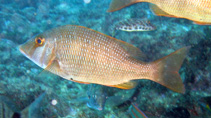Lethrinus atlanticus Valenciennes, 1830
Atlantic emperor
Add your observation in Fish Watcher
| Native range | All suitable habitat | Point map | Year 2050 |

|
| This map was computer-generated and has not yet been reviewed. |
| Lethrinus atlanticus AquaMaps Data sources: GBIF OBIS |
Upload your photos and videos
Pictures | Google imageLethrinus atlanticus
Picture by Wirtz, P.
Pictures | Google imageLethrinus atlanticus
Picture by Wirtz, P.
Guinea country information
Common names:
Sinapa khamè
Occurrence: native
Salinity: marine
Abundance: | Ref:
Importance: | Ref:
Aquaculture: | Ref:
Regulations: | Ref:
Uses: no uses
Comments: Reported from the Guinea shelf (Ref. 47102).
National Checklist:
Country Information: https://www.cia.gov/library/publications/resources/the-world-factbook/geos/gv.html
National Fisheries Authority: http://www.fis-net.com/guinea
Occurrences: Occurrences Point map
Main Ref: Carpenter, K.E. and G.R. Allen, 1989
National Database:
Occurrence: native
Salinity: marine
Abundance: | Ref:
Importance: | Ref:
Aquaculture: | Ref:
Regulations: | Ref:
Uses: no uses
Comments: Reported from the Guinea shelf (Ref. 47102).
National Checklist:
Country Information: https://www.cia.gov/library/publications/resources/the-world-factbook/geos/gv.html
National Fisheries Authority: http://www.fis-net.com/guinea
Occurrences: Occurrences Point map
Main Ref: Carpenter, K.E. and G.R. Allen, 1989
National Database:
Common names from other countries
Classification / Names Common names | Synonyms | Catalog of Fishes(genus, species) | ITIS | CoL | WoRMS | Cloffa
Teleostei (teleosts) > Eupercaria/misc (Various families in series Eupercaria) > Lethrinidae (Emperors or scavengers) > Lethrininae
Etymology: Lethrinus: Greek, lethrinia, a fish pertaining to genus Pagellus.
More on author: Valenciennes.
Etymology: Lethrinus: Greek, lethrinia, a fish pertaining to genus Pagellus.
More on author: Valenciennes.
Environment: milieu / climate zone / depth range / distribution range Ecology
Marine; reef-associated; non-migratory; depth range 1 - 50 m (Ref. 2683). Tropical; 20°N - 5°S
Distribution Countries | FAO areas | Ecosystems | Occurrences | Point map | Introductions | Faunafri
Eastern Central Atlantic: Senegal to Gabon; also Cape Verde, São Tome-Principe Islands, and Rolas Islands. There is little doubt that only a single species of Lethrinus exists in the tropical western Atlantic.
Length at first maturity / Size / Weight / Age
Maturity: Lm 22.8, range 21 - ? cm
Max length : 50.0 cm TL male/unsexed; (Ref. 2295); common length : 30.0 cm TL male/unsexed; (Ref. 2295)
Max length : 50.0 cm TL male/unsexed; (Ref. 2295); common length : 30.0 cm TL male/unsexed; (Ref. 2295)
Short description Identification keys | Morphology | Morphometrics
Dorsal spines (total): 10; Dorsal soft rays (total): 9; Anal spines: 3; Anal soft rays: 8. The outer surface of the maxilla is smooth, without a knob or pronounced longitudinal ridge. Inner surface of the pectoral fin axil without scales. Overall color is olive green or brown and pinkish. The cheeks have a network of fine reticulations below the eye.
Found in shallow coastal waters (Ref. 2263). Feeds mainly on bottom-dwelling invertebrates. Marketed fresh (Ref. 171), smoked and dried salted (Ref. 2295). Abundant during the winter months (Ref. 2683).
Life cycle and mating behavior Maturity | Reproduction | Spawning | Eggs | Fecundity | Larvae
Main reference
Upload your references | References | Coordinator | Collaborators
Carpenter, K.E. and G.R. Allen, 1989. FAO Species Catalogue. Vol. 9. Emperor fishes and large-eye breams of the world (family Lethrinidae). An annotated and illustrated catalogue of lethrinid species known to date. FAO Fish. Synop. 125(9):118 p. Rome: FAO. (Ref. 2295)
Threat to humans
Harmless
Human uses
Fisheries: commercial
FAO(Fisheries: production; publication : search) | FishSource | Sea Around Us
More information
Population dynamics
Growth parameters
Max. ages / sizes
Length-weight rel.
Length-length rel.
Length-frequencies
Mass conversion
Recruitment
Abundance
Growth parameters
Max. ages / sizes
Length-weight rel.
Length-length rel.
Length-frequencies
Mass conversion
Recruitment
Abundance
Life cycle
Reproduction
Maturity
Fecundity
Spawning
Spawning aggregations
Eggs
Egg development
Larvae
Larval dynamics
Reproduction
Maturity
Fecundity
Spawning
Spawning aggregations
Eggs
Egg development
Larvae
Larval dynamics
Anatomy
Gill area
Brain
Otolith
Gill area
Brain
Otolith
Physiology
Body composition
Nutrients
Oxygen consumption
Swimming type
Swimming speed
Visual pigments
Fish sound
Diseases & Parasites
Toxicity (LC50s)
Body composition
Nutrients
Oxygen consumption
Swimming type
Swimming speed
Visual pigments
Fish sound
Diseases & Parasites
Toxicity (LC50s)
Genetics
Genetics
Heterozygosity
Heritability
Genetics
Heterozygosity
Heritability
Human related
Aquaculture systems
Aquaculture profiles
Strains
Ciguatera cases
Stamps, coins, misc.
Aquaculture systems
Aquaculture profiles
Strains
Ciguatera cases
Stamps, coins, misc.
Tools
Bio-Quiz | E-book | Field guide | Length-frequency wizard | Life-history tool | Point map | Classification Tree
| Catch-MSY |
Special reports
Download XML
Internet sources
Aquatic Commons | BHL | Cloffa | Websites from users | Check FishWatcher | CISTI | Catalog of Fishes(genus, species) | DiscoverLife | ECOTOX | Faunafri | Fishtrace | GenBank(genome, nucleotide) | GloBI | GOBASE | | Google Books | Google Scholar | Google | IGFA World Record | MitoFish | Otolith Atlas of Taiwan Fishes | PubMed | Reef Life Survey | Scirus | SeaLifeBase | Tree of Life | Wikipedia(Go, Search) | World Records Freshwater Fishing | Zoobank | Zoological Record
Estimates based on models
Preferred temperature (Ref. 115969): 24.4 - 28, mean 26.6 (based on 60 cells).
Phylogenetic diversity index (Ref. 82804): PD50 = 0.5000 [Uniqueness, from 0.5 = low to 2.0 = high].
Bayesian length-weight: a=0.01479 (0.00917 - 0.02386), b=2.95 (2.82 - 3.08), in cm Total Length, based on LWR estimates for this species & Genus-body shape (Ref. 93245).
Trophic level (Ref. 69278): 3.5 ±0.46 se; based on food items.
Resilience (Ref. 120179): Medium, minimum population doubling time 1.4 - 4.4 years (Assuming tm=2).
Fishing Vulnerability (Ref. 59153): Low vulnerability (21 of 100).
Climate Vulnerability (Ref. 125649): High to very high vulnerability (74 of 100).




